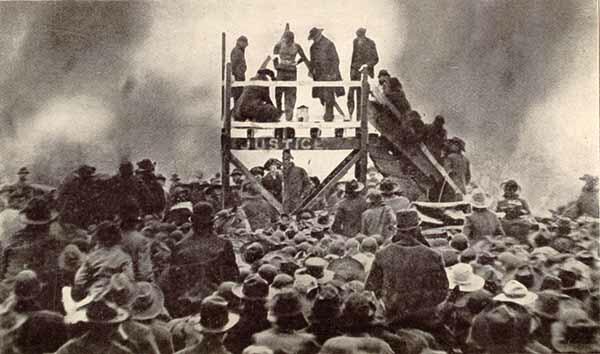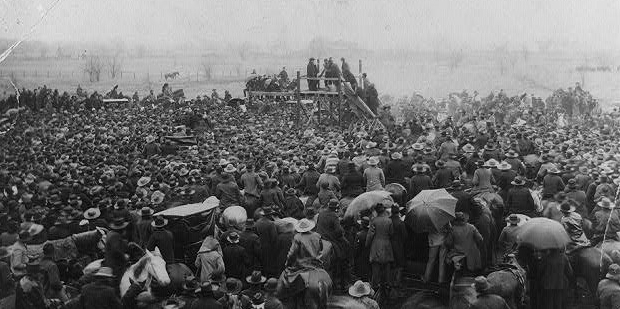We’ve covered the lynching of Will Brown, Jesse Washington, Emmett Till and the cruel fate which met countless others.
Far from the mob which bay for the blood of the lynched seeking justice, history has shown that a good number of the accusations were false with many of the supposed victims coming out to confess the vile role they played in snuffing the life of many innocent African-Americans.
Of course, if any member of society commits a crime, he must face the consequence but his or her guilt must be proved in a competent court.
The practice of Black Americans being accused of one crime or the other and in court houses or jail houses white mobs amass, retrieve and then shoot and burn or mutilate the bodies is unacceptable then and now.
Henry Smith was accused of the rape and murder of four-year-old Myrtle Vance, daughter of a law enforcement officer. Ida B. Wells, a notable civil rights activists and publisher per reports from local residents, held that Smith had indeed strangled the child to death but the grisly details were invented by the child’s relatives and neighbors.
Smith, an African-American handyman is said to have been beaten by a law enforcement officer during an arrest. He was mentally retarded.

Smith had been seen acting drunk plus being disorderly. Deputy Henry Vance was sent to arrest him. Smith resisted and Vance “was forced to use his club” to subdue him. On Thursday, January 26, 1893, Vance’s three-year-old daughter disappeared from the front of the boarding house where her family lived. Witnesses said they saw Smith “picked up little Myrtle Vance … and … carry her through the central portion of the city. Smith is said to have then left and was not seen again until he was captured in Arkansas.”
About 2:00 p.m. on Friday, January 27, 1893, a search party formed at the courthouse and found the child’s body covered by leaves in Gibson’s pasture. When the girl was found dead on the side of a road, the townspeople were furious. Rumor spread that the victim had suffered severe injuries from rape and physical mutilation.
But an investigation by journalist Ida B. Wells revealed it was her opinion that the rape accusation was false.
“As a matter of fact, the child was not brutally assaulted as the world has been told in excuse for the awful barbarism of that day. Persons who saw the child after its death, have stated, under the most solemn pledge to truth, that there was no evidence of such an assault as was published at that time, only a slight abrasion and discoloration was noticeable and that mostly about the neck.
“Henry Smith was located at a train station along the Arkansas and Louisiana Railway, about 20 miles from Hope, Arkansas. Along the way back to Paris crowds gathered to see Smith. At one station someone tried to attack him with a knife when he looked out the train window. Smith was reportedly told that he would be tortured and burned to death, and he begged members of the posse to shoot him dead.”
On February 1, 1893, the New York Times carried a small item on its front page headlined “To Be Burned Alive.”
The news item read: “The negro Henry Smith, who assaulted and murdered four-year-old Myrtle Vance, has been caught and will be brought here tomorrow. He will be burned alive at the scene of his crime tomorrow evening. All the preparations are being made.”
When he was returned to town, the local citizens proudly announced they would burn him alive.
“On February 1, 1893, the killing of Smith was carefully orchestrated. The townspeople constructed a large wooden platform near the center of town. And in view of thousands of spectators, Smith was tortured with hot irons for nearly an hour before being soaked with kerosene and set ablaze.”

Smith’s peculiar murder stunned the nation with Ida B. Wells, the notable anti-lynching journalist writing in her landmark book, The Red Record:
“Never in the history of civilization has any Christian people stooped to such shocking brutality and indescribable barbarism as that which characterized the people of Paris, Texas, and adjacent communities on the first of February, 1893.”
At noon on February 1, scaffold had been built, about ten feet high, upon which he would be burned in full view of the spectators.
“Smith was tied up and tortured for 50 minutes by Henry Vance, his 15-year-old son, and his brother-in-law. The men placed hot irons under Smith’s feet, burned his trunk and limbs, burned both eyes out with hot irons and then shoved a hot iron down his throat. A February 2, 1893 article in the New York Sun reported, “Every groan from the fiend, every contortion of his body was cheered by the thickly packed crowd.” The February 2 edition of the Boston Daily Globe deemed Smith’s grotesque execution “White Savagery” and claimed “Civilization Seemingly a Failure in Texas.”
“Finally, the crowd poured coal oil (kerosene) over Smith and set the scaffold on fire. According to some newspaper accounts, Smith remained alive during the burning. When the flames rose high enough, they burned the rope that bound Smith to the stake away and he fell off the scaffolding. At the base of the burning platform, Smith attempted to twist away from the flames, but onlookers kicked him back into the conflagration. After the fire reduced Smith’s body to brittle cinder, members of the surrounding crowd moved in and sifted through the ashes to collect Smith’s bones and shards of wood as souvenirs. On February 6, 1893, the governor of Texas, James Hogg, referred to the lynching of Henry Smith as a “terrible holocaust” and railed against mob violence in the state.”

“Photographs of the torture and burning of Smith were taken and were later sold as prints and postcards. And according to some accounts, his agonized screams were recorded on a primitive graphophone and later played before audiences as images of his killing were projected on a screen.”
An article on the front page of the New York Times the following morning described how the city government cooperated with the bizarre event, even closing the local schools (presumably so the children could attend with the parents. It marks another awful moment in America’s troubled history with its Black citizens. This time 10,000 white people poured into Paris, Texas to witness this barbarity.
The perpetrators of the lynching, which included men who were readily identified, were never punished.










